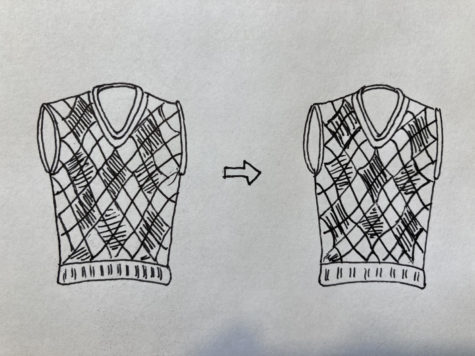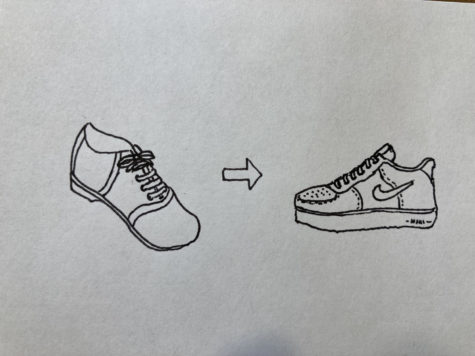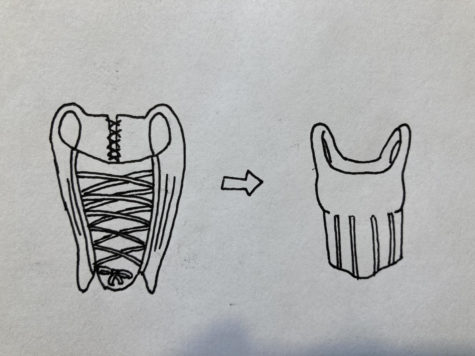Not-so-new style
Trends that you knew were vintage, and trends that you didn’t
February 8, 2022
Increasingly popular on TikTok, thrifting is in. Vintage clothes you find in Goodwill, everything from 1990s Nike sweatshirts to an old sweater that once belonged to Noreen’s husband, are now making headway strutting through the Shorewood hallways. There are plenty of things that people see as vintage. But all fashion has to come from somewhere, and many vintage styles are making a resurgence without being classified under the “just got a haul from the bins” category.
So what qualifies as vintage? Not everyone agrees. Is it something from before the 1970s? Is something from the 2000s vintage now? For fashion, the terms vintage and retro are used relatively fluidly. Though the term vintage does seem to bring some distinction between that old shirt that your grandparents make you wear for painting the house and a desirable Metallica shirt from the back of a garage sale clothing rack.
Vintage is cool. That old painting shirt is not. That’s just old.
It’s important to note that not everything that is seen as “vintage” is actually a historical piece of clothing.
Thrift stores have been very full of fast-fashion items that resemble vintage styles but are actually rejects from an influencer Shein haul.
There are some clothing pieces many people already associate with vintage fashion. Around Shorewood, the first-place winner these days for the decades seems to be the 1960s and ‘70s. The blues, greens, and pink florals are once again back from the ‘60s. Those bell-bottom pants you love: ‘70s. Platform shoes and leather pants: ‘70s. Paring a tank top on top of a turtleneck: a ‘60s and ‘70s combo.
Additionally coming back in style is the popular sweater vest that 1950s teenage boys headed off to school in. Pairing the vests with baggy slacks contributes to the mid-century homage. Many fashion companies have invested in this trend towards vintage looks, sweaters complete with squares, diamonds, and line patterns right from the middle of the 20th century.

Cuffed jeans are becoming less present, but still appear. You might think jean cuffs come from the 1980s, but this practice goes back to the late 1800s when denim was emerging and laborers would buy their jeans too big because there was no such thing as pre-shrunk.
Some of these trends come with the vintage label on them. There are other trends that may not have been directly created from a past trend, but most styles do reflect something from the past.
For example: the 1400s are making a resurgence. What? Isn’t that medieval? No one’s repping the Leonardo Da Vinci drip!
Actually, two colored pants, where one leg is one color, and the other leg is another, have been making a reappearance in modern fashion. This reflects back to European men’s hose (legging-like pants worn underneath a tunic). If you look at period paintings, one can spot the occasional Edmund rocking a one leg blue and one leg yellow combo.
Additionally, there are the white shoes. In the 1940s teenagers were commonly found wearing white leather shoes. Two tone shoes (Oxfords), a large portion of them white, were hugely common on the feet of your 1940s American teen. Yes, Margaret and Jim were also worrying about getting mud on their white shoes, just like you are with your Air Forces.

Another connection to past fashion trends lands in low cut blouses with puffy sleeves which resemble the cut of 1950s gowns, which resemble the shape of 1830s women’s evening wear.
Additionally, corset tops often bear similarity to the construction of women’s stays (1700s) and corsets (1800s and 1900s) which were supportive garments worn over the chemise (underwear) and underneath a top
Love that baggy oversized tee-shirt? The baggy pants, oversized sweater or jacket?
Oversized clothing began gaining popularity in the ‘90s, with the general trend towards loose-fitting casual wear and the development of streetwear fashion within hip-hop culture. Earlier in Harlem though, there was a similar trend towards baggier clothing. Zoot suits, oversized suits, began being worn in Harlem in the 1930s, and soon the trend spread across many groups throughout the 1940s including many minority groups in the United States.
In fact, modern fashion has adopted many trends which were popularized by Black culture like bucket hats and our love of sneakers.
It’s exceptionally important to note that many fashion trends don’t give credit to the
actual culture of the trend’s creation, leading people to consider a design just trendy without actually reflecting on the community which has created or utilized this trend. Some things just coincidentally look like a past clothing piece. Others are made directly from them.
It can be said of almost any new fashion trend, this probably came from somewhere. After all, clothes have been around for a long time. But, it’s up to you to put your unique spin on it, love an old style again, or make a new one out of it.
We, for centuries, have used fashion as a way to express ourselves.
So, what are you wearing?



